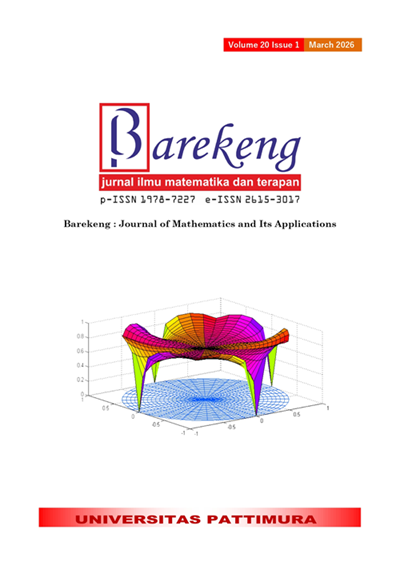NOWCASTING GROWTH AT RISK IN INDONESIA: APPLICATION OF MIDAS-QUANTILE REGRESSION MODEL
Abstract
One of the main problems faced by policymakers in economic monitoring is the limited availability of predictive tools that can comprehensively and in real time measure economic growth risks, particularly amid financial market volatility and rapid changes in economic indicators. This study aims to nowcast Indonesian economic growth using the Growth at Risk (GaR) approach by applying the Mixed Data Sampling-Quantile Regression (MIDAS-QR) model. This approach predicts economic risks across different quantiles, capturing best- and worst-case scenarios by integrating multi-frequency indicators, namely the Financial Conditions Index (FCI), External Financial Environment Index (EFEI), and Macroeconomic Prosperity Leading Index (MPLI), summarized using Principal Component Analysis (PCA). Prediction accuracy is evaluated using Quantile Mean Absolute Error (QMAE), Quantile Root Mean Squared Error (QRMSE), and Clark-West (CW) test metrics. The analysis utilizes a dataset of Indonesia covering the period from January 2001 to March 2025, combining quarterly GDP growth data as the dependent variable and monthly predictor variables sourced from the Central Statistics Agency (BPS), Bank Indonesia, and the Indonesia Stock Exchange. The findings show that the MIDAS-QR model significantly improves the accuracy of GaR forecasting in Indonesia relative to conventional approaches. It effectively captures risk asymmetries across quantiles, minimizes predictive errors, and facilitates the timely detection of economic downturns, offering valuable insights for early action. This study highlights the strategic role of high-frequency data in enhancing forecast precision and real-time economic risk monitoring in Indonesia. The application of the MIDAS-QR model presents a valuable tool for policymakers in formulating proactive responses to global economic uncertainty and fostering resilient economic growth.
Downloads
References
J. Melka, “INDONESIA: OUTLOOK IS STRONG BUT VULNERABLE TO EXTERNAL SHOCKS,” BNP PARIBAS, no. January, pp. 11–12, 2025, [Online]. Available: https://economic-research.bnpparibas.com/html/en-US/Indonesia-Outlook-strong-vulnerable-external-shocks-2/11/2025,51313
LPEM FEB UI, “INDONESIA ECONOMIC OUTLOOK 2025,” pp. 1–30, 2024, [Online]. Available: lpem.org/wp-content/uploads/2024/08/IEO-Q3-2024-ID.pdf
J. Menon, “SOUTHEAST ASIA’S ECONOMIC PERFORMANCE IN 2024 AND OUTLOOK FOR 2025: NAVIGATING RISING RISKS,” FULCRUM SG. Accessed: Feb. 04, 2025. [Online]. Available: https://fulcrum.sg/southeast-asias-economic-performance-in-2024-and-outlook-for-2025-navigating-rising-risks/
OECD, ECONOMIC OUTLOOK FOR SOUTHEAST ASIA, CHINA AND INDIA 2023 - UPDATE. in Economic Outlook for Southeast Asia, China and India. OECD, 2023. doi: https://doi.org/10.1787/cd94bcf6-en.
E. Ghysels, V. Kvedaras, and V. Zemlys, “MIXED FREQUENCY DATA SAMPLING REGRESSION MODELS: THE R PACKAGE MIDASR,” J. Stat. Softw., vol. 72, no. 4, pp. 1–35, 2016. doi: https://doi.org/10.18637/jss.v072.i04.
W. H. Saputra, D. D. Prastyo, and H. Kuswanto, “MACHINE LEARNING MODELING ON MIXED-FREQUENCY DATA FOR FINANCIAL GROWTH AT RISK,” Procedia Comput. Sci., vol. 234, pp. 397–403, 2024. doi: https://doi.org/10.1016/j.procs.2024.03.020.
T. Adrian, N. Boyarchenko, and D. Giannone, “VULNERABLE GROWTH,” Am. Econ. Rev., vol. 109, no. 4, pp. 1263–1289, Apr. 2019, doi: https://doi.org/10.1257/aer.20161923.
Q. Zhang, H. Ni, and H. Xu, “NOWCASTING CHINESE GDP IN A DATA-RICH ENVIRONMENT: LESSONS FROM MACHINE LEARNING ALGORITHMS,” Econ. Model., vol. 122, p. 106204, May 2023. doi: https://doi.org/10.1016/j.econmod.2023.106204.
N.-S. Kwark and C. Lee, “ASYMMETRIC EFFECTS OF FINANCIAL CONDITIONS ON GDP GROWTH IN KOREA: A QUANTILE REGRESSION ANALYSIS,” Econ. Model., vol. 94, pp. 351–369, Jan. 2021. doi: https://doi.org/10.1016/j.econmod.2020.10.014.
T. Adrian and F. Vitek, “MANAGING MACROFINANCIAL RISK. IMF WORK,” International Monetary Fund, 2020. [Online]. Available: https://www.imf.org/en/Publications/WP/Issues/2020/08/07/Managing-Macrofinancial-Risk-49598. doi: https://doi.org/10.5089/9781513550893.001
Q. Xu, M. Xu, C. Jiang, and W. Fu, “MIXED-FREQUENCY GROWTH-AT-RISK WITH THE MIDAS-QR METHOD: EVIDENCE FROM CHINA,” Econ. Syst., vol. 47, no. 4, pp. 1–12, Dec. 2023. doi: https://doi.org/10.1016/j.ecosys.2023.101131 .
T. Adrian, D. He, N. Liang, and F. Natalucci, “A MONITORING FRAMEWORK FOR GLOBAL FINANCIAL STABILITY, IMF STAFF DISCUSSION NOTE SDN/19/06,” Int. Monet. Fund, 2019. doi: https://doi.org/10.5089/9781498300339.006
M. G. Chadwick and H. Ozturk, “MEASURING FINANCIAL SYSTEMIC STRESS FOR TURKEY: A SEARCH FOR THE BEST COMPOSITE INDICATOR,” Econ. Syst., vol. 43, no. 1, pp. 151–172, Mar. 2019. doi: https://doi.org/10.1016/j.ecosys.2018.09.004
X. Zhang and L. Liu, “FINANCIAL RISK AND ECONOMIC GROWTH UNDER THE NEW PARADIGM OF MACRO-ANALYSIS ON THE IMPACT OF THE COVID-19 PANDEMIC AND GROWTH AT RISK,” Econ. Res. J., vol. 55, pp. 4–21, 2020.
L. R. Lima, F. Meng, and L. Godeiro, “QUANTILE FORECASTING WITH MIXED-FREQUENCY DATA,” Int. J. Forecast., vol. 36, no. 3, pp. 1149–1162, Jul. 2020. doi: https://doi.org/10.1016/j.ijforecast.2018.09.011
Q. Xu, L. Chen, C. Jiang, and K. Yu, “MIXED DATA SAMPLING EXPECTILE REGRESSION WITH APPLICATIONS TO MEASURING FINANCIAL RISK,” Econ. Model., vol. 91, pp. 469–486, Sep. 2020. doi: https://doi.org/10.1016/j.econmod.2020.06.018
E. Ghysels, V. Kvedaras, and V. Zemlys-Balevičius, “CHAPTER 4 - MIXED DATA SAMPLING (MIDAS) REGRESSION MODELS,” in Handbook of Statistics, vol. 42, H. D. Vinod and C. R. Rao, Eds., in Handbook of Statistics, vol. 42. , Elsevier, 2020, CH. Chapter 4, pp. 117–153. doi: https://doi.org/10.1016/bs.host.2019.01.005
D. T. Utari and H. Ilma, “COMPARISON OF METHODS FOR MIXED DATA SAMPLING (MIDAS) REGRESSION MODELS TO FORECAST INDONESIAN GDP USING AGRICULTURAL EXPORTS,” in AIP Conference Proceedings, 2018, p. 060016. doi: https://doi.org/10.1063/1.5062780
R. Koenker, “QUANTILE REGRESSION: 40 YEARS ON,” Annu. Rev. Econom., vol. 9, no. 1, pp. 155–176, Aug. 2017. doi: https://doi.org/10.1146/annurev-economics-063016-103651
J. Suarez, “GROWTH-AT-RISK AND MACROPRUDENTIAL POLICY DESIGN,” J. Financ. Stab., vol. 60, 2022. doi: https://doi.org/10.1016/j.jfs.2022.101008
L. Ferrara, M. Mogliani, and J.-G. Sahuc, “HIGH-FREQUENCY MONITORING OF GROWTH AT RISK,” Int. J. Forecast., vol. 38, no. 2, pp. 582–595, Apr. 2022. doi: https://doi.org/10.1016/j.ijforecast.2021.06.010
S. M. Juhro and B. N. Iyke, “MONETARY POLICY AND FINANCIAL CONDITIONS IN INDONESIA,” Bul. Ekon. Monet. dan Perbank., vol. 21, no. 3, pp. 283–302, Feb. 2019. doi: https://doi.org/10.21098/bemp.v21i3.1005
P. M. Pincheira and K. D. West, “A COMPARISON OF SOME OUT-OF-SAMPLE TESTS OF PREDICTABILITY IN ITERATED MULTI-STEP-AHEAD FORECASTS,” Res. Econ., vol. 70, no. 2, pp. 304–319, Jun. 2016. doi: https://doi.org/10.1016/j.rie.2016.03.002
E. Ghysels, L. Iania, and J. Striaukas, “QUANTILE-BASED INFLATION RISK MODELS,” National Bank of Belgium, Brussels, 2018.
L. WU and J. QIU, APPLIED MULTIVARIATE STATISTICAL ANALYSIS AND RELATED TOPICS WITH R. EDP SCIENCES, 2021. doi: https://doi.org/10.1051/978-2-7598-2602-5
Copyright (c) 2025 Turfah Latifah, Muhammad Sjahid Akbar, Dedy Dwi Prastyo

This work is licensed under a Creative Commons Attribution-ShareAlike 4.0 International License.
Authors who publish with this Journal agree to the following terms:
- Author retain copyright and grant the journal right of first publication with the work simultaneously licensed under a creative commons attribution license that allow others to share the work within an acknowledgement of the work’s authorship and initial publication of this journal.
- Authors are able to enter into separate, additional contractual arrangement for the non-exclusive distribution of the journal’s published version of the work (e.g. acknowledgement of its initial publication in this journal).
- Authors are permitted and encouraged to post their work online (e.g. in institutional repositories or on their websites) prior to and during the submission process, as it can lead to productive exchanges, as well as earlier and greater citation of published works.






1.gif)



